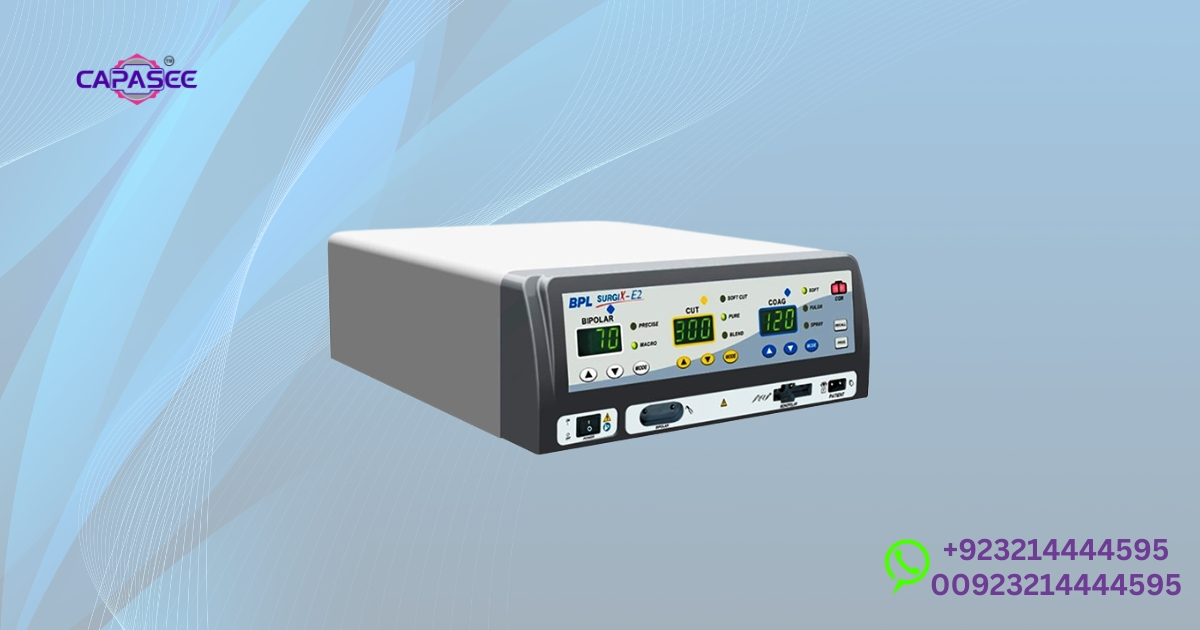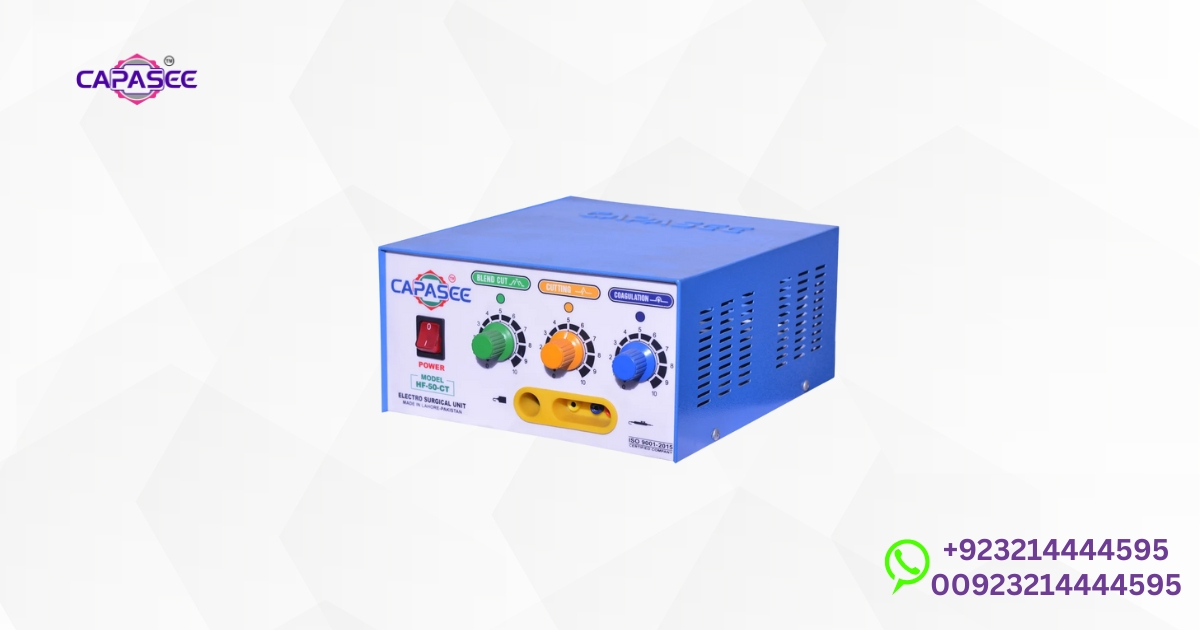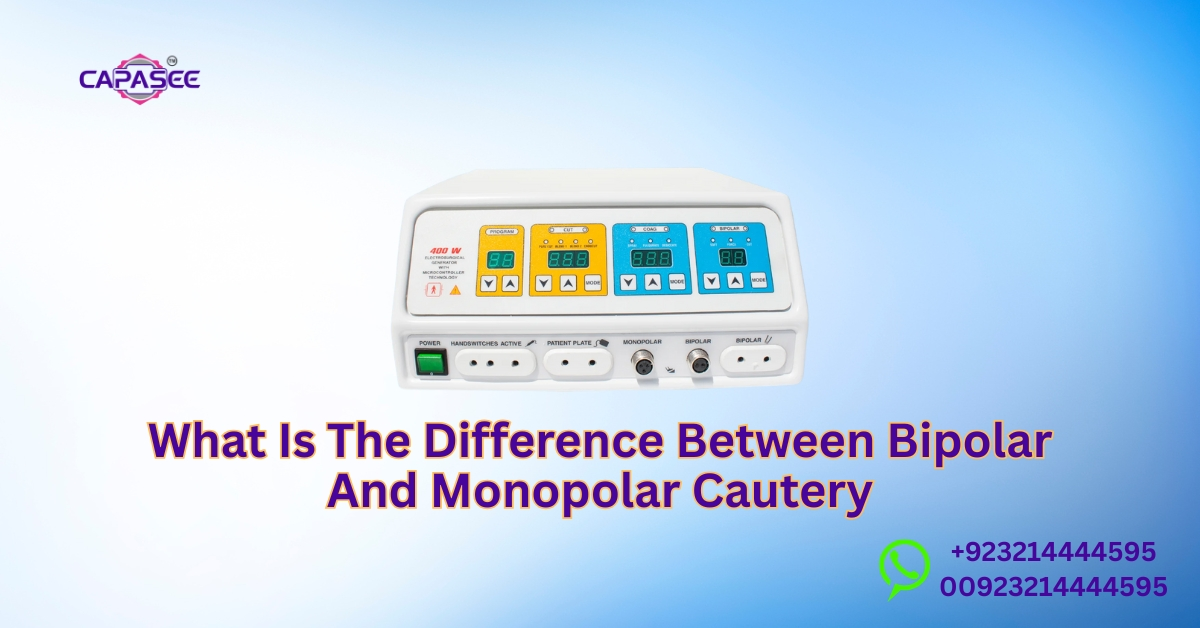Have you ever questioned yourself why doctors use various types of cauteries when operating and what is their uniqueness? You’re not alone. Most people listen to terms such as bipolar and monopolar cautery, and during medical chats, they are confused about the meaning of the terms and when one uses them. We all desire to have clear answers, and when it comes to surgery, one would want to have precision and safety.
This blog will discuss what is bipolar versus monopolar in a simple, easy to understand manner. You will be informed about how each of them works, in what position they are applicable, and which of them is safer to use in particular medical processes. At the end, you will have a real picture of how doctors make the two decisions and the reason why it is more important than you may think.
Exploring Bipolar and Monopolar Cautery: Detailed Electrosurgical Cautery Types by Capasee

Two significant types of electrosurgical instruments that were utilized in surgery in cutting and sealing of tissues are bipolar and monopolar cautery. They are used in the operation of the surgical energy sources through which electrical current is passed through the tissues, enabling the surgical coagulation techniques and cutting techniques to be more precise and controlled by the doctors.
Bipolar cautery, the current is applied between two ends of the forceps, forming a localized effect on the current and minimizing the possibility of burns. In monopolar cautery, the current flows through the body of the patient to a ground pad, whereas the cutting power is wider, but the risks of dispersive electrodes are greater. Capasee Electro Medical Engineering makes sure that all electrosurgical cautery practices are conducted in the best safety and quality standards that are believed in by all hospitals in Pakistan.
| Type | Current Flow | Tissue Effect | Risk Level | Common Use |
| Bipolar Cautery | Between two forceps tips | Localized tissue coagulation depth | Low | Delicate surgeries like neurosurgery cautery tools |
| Monopolar Cautery | From electrode to return pad | Broad tissue effect | Moderate to high | General surgery and endoscopic surgery cautery |
Bipolar Cautery Advantages and Benefits in Surgery: Effective Bleeding Control and Hemostasis
The benefits of using bipolar cautery are that it provides better surgical coagulation and cutting capabilities, enhanced healing, and the tissue trauma. The safety of bipolar cautery is well known since it does not cause accidental spreading of current and also reduces the amount of tissue damage in this type of cautery. This is ideal in microsurgeries and vascular operations where a great deal of precision in electrosurgical cautery operations is involved.
Physicians would prefer bipolar cautery when carrying out sensitive surgeries like the brain and spine. Its electrode configuration in the cautery surgical operation enables precise control of the electrode depth to provide clean coagulation of tissues without unnecessary burns. These advantages ensure that the use of bipolar systems is an effective component of the current electrocautery methods that would ensure safer and more precise outcomes among the patients in Pakistan.
You May Also Read This Blog: What Fluid Is Used In Monopolar Cautery
Monopolar Cautery Risks and Side Effects: Thermal Damage and Cauterization Effects
The monopolar cautery mechanism is based on the current passing through the body of the patient and causing burns to the body through a dispersive pad, which may pose a risk of burns in monopolar cautery unless well handled. It gives a wide tissue effect that is applicable in larger areas during surgery, but has more potential of causing thermal damage than bipolar systems do.
In general surgery with the use of monopolar cautery, a proper electrode positioning of the cautery and continuous observation of the grounding pads should be provided by a surgeon. Even though it is efficient when used to coagulate rapidly and cut surgically, a comparison of tissue damage in types of cautery revealed that monopolar tools might produce more heat dispersion. There is a balance between efficiency and security because risks can be reduced with proper techniques and safety measures of using monopolar cautery.
Bipolar and Monopolar Cautery: Key Technique Differences and Safety Insights
The two most popular types of electrosurgical instruments used in contemporary operating rooms are bipolar and monopolar cautery. These procedures are based on the use of surgical sources of energy that produce controlled heat that prevents bleeding and also carry out precise surgical cutting procedures. Capasee Electro Medical Engineering is a company that provides doctors with innovative surgical cauterization tools in Pakistan in hospitals, which are accurate, precise, and safe for patients.
In a bipolar cauterisation, the current flows between only two tips of the forceps and this produces a focal effect on heating. Monopolar cautery involves conduction of the current through the body of the patient and through a dispersive pad and dispersive electrode; hazards are elevated. This draws a line between bipolar and monopolar cautery because the energy reacting to the tissue varies depending on the type used, and it is therefore important to choose the right one to achieve safe and effective outcomes.
| Type | Current Path | Heat Spread | Primary Use | Risk Level |
| Bipolar Cautery | Between two electrodes | Localized versus broad tissue effect (localized) | Use of bipolar cautery in delicate surgeries | Low |
| Monopolar Cautery | From active electrode to dispersive pad | Broad and deeper | Monopolar cautery in general surgery | Moderate |
Bipolar vs Monopolar Tissue Damage: Comparing Procedure Outcomes and Safety from Capasee Experts

There are evident differences in the tissue damage comparison in the type of cautery. Bipolar cautery benefits consist of enhanced safety of the bipolar cautery and the depth of tissue coagulation being insignificant; thus, bipolar cautery is the best choice in microsurgeries. Monopolar cautery mechanism, however, permits broader utilization of power to large regions, but it is capable of raising a burn risk in monopolar cautery, provided the electrode arrangement is not performed incorrectly.
Capasee professionals claim that bipolar cautery applications apply to brain, nerve, and cardiac surgeries in which the precision of electrosurgical procedures is most crucial. On the other hand, monopolar systems have the advantage of removing thick tissues and coagulating large surfaces. Knowledge of the local and global tissue effects of each system can enable the surgeons to minimize damage and ensure a successful recovery of the patients in Pakistan.
How Capasee Optimizes Bipolar Cautery for Internal Thoracic Artery Procedures
Capasee is oriented to improve the benefits of bipolar cautery in critical cardiac operations, particularly internal thoracic artery surgeries. The high tech electrosurgical devices of the company provide the consistency of temperature control, as well as a steady manner of tissue coagulation, enabling surgeons to produce clear, bloodless surfaces at lower collateral temperatures.
In these sensitive procedures, proper placement of the electrodes in cautery ensures that the energy flows safely and no tissue burns. This application of bipolar cautery in delicate surgeries forms one of the foundations of the innovations by Capasee, which also incorporate smart monitoring of electrosurgical accuracy. These are additions that enable Pakistani surgeons to attain clean cuts and better outcomes in surgical coagulation and cutting on each occasion.
Check More: Our Products
Comprehensive Electrosurgery Cautery Comparison: Monopolar Cautery vs Bipolar Safety and Technique
In a comparison of monopolar and bipolar electrocautery current flow and energy pathways, it is evident that the bipolar and monopolar cautery systems are aimed at different surgical objectives. The safety of monopolar cautery is based on the position of the grounding pad and temperature regulation, whereas the safety of the bipolar system is based on the close tip stream of current to provide tissue coagulation depth.
Capasee Electro Medical Engineering has integrated the two technologies in its endoscopic surgery cautery and neurosurgery cautery devices to provide the surgeons with reliable, safe, and viable options. Their designs offer the benefits of bipolar cautery and the effectiveness of monopolar cautery in general surgery, in that the designs provide a smooth outcome and decrease complication rates in Pakistani hospitals.
Table: Summary of Bipolar and Monopolar Comparison
| Feature | Bipolar Cautery | Monopolar Cautery |
| Current Direction | Between two electrodes | Through patient to dispersive pad |
| Energy Focus | Localized | Wide area |
| Risk | Low | Moderate to high |
| Best Use | Neurosurgery, microvascular | General, open field surgeries |
| Tools by Capasee | Smart bipolar forceps | Advanced monopolar electrodes |
The innovation orientation of Capasee also means that all Pakistani hospitals will enjoy safer and smarter electrocautery methods that are constructed using the international surgical cauterization tools standards.
Frequently Asked Questions
What is the difference between monopolar and bipolar cautery?
Monopolar cautery is applied to all parts of a patient, whereas bipolar cautery is applied to one area using two tips of forceps.
What is a bipolar cautery used for?
Bipolar cautery applies in sensitive surgeries such as brain or heart surgeries, where minimal tissue damage and high level control are required.
What is monopolar cautery used for?
General surgeries involve the cutting or coagulation of large tissue, and hence, require monopolar use.
What are the two types of cautery?
These are the two principal types, which include monopolar cautery and bipolar cautery, which utilize electrical energy to cut and control bleeding.
Is monopolar cautery safe to use?
Yes, monopolar cautery is safe provided that there is good grounding and electrode positioning by trained surgical professionals.
Conclusion
Bipolar and monopolar cautery are important in the attainment of focused cutting and safe tissue control. These two procedures involve high end electrosurgical tools to prevent bleeding and enhance visibility in surgical operations. Although bipolar cautery has a narrowed down precision and minimal heat dispersion, monopolar cautery has quicker outcomes when used on a large surgical site. Knowledge of the time to apply each will make patients and surgery safer and efficient. Hospitals in Pakistan also carry out safer, more controlled, and effective surgical operations with the help of technology provided by Capasee Electro Medical Engineering.

